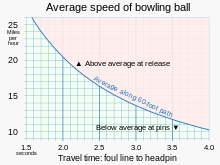
Speed

This article needs additional citations for verification. (July 2016) |

| Speed | |
|---|---|
 Speed can be thought of as the rate at which an object covers distance. A fast-moving object has a high speed and covers a relatively large distance in a given amount of time, while a slow-moving object covers a relatively small amount of distance in the same amount of time. | |
Common symbols | v |
| SI unit | m/s, m s−1 |
| Dimension | L T−1 |
In kinematics, the speed (commonly referred to as v) of an object is the magnitude of the change of its position over time or the magnitude of the change of its position per unit of time; it is thus a non-negative scalar quantity.[1] The average speed of an object in an interval of time is the distance travelled by the object divided by the duration of the interval;[2] the instantaneous speed is the limit of the average speed as the duration of the time interval approaches zero. Speed is the magnitude of velocity (a vector), which indicates additionally the direction of motion.

Speed has the dimensions of distance divided by time. The SI unit of speed is the metre per second (m/s), but the most common unit of speed in everyday usage is the kilometre per hour (km/h) or, in the US and the UK, miles per hour (mph). For air and marine travel, the knot is commonly used.

The fastest possible speed at which energy or information can travel, according to special relativity, is the speed of light in vacuum c = 299792458 metres per second (approximately 1079000000 km/h or 671000000 mph). Matter cannot quite reach the speed of light, as this would require an infinite amount of energy. In relativity physics, the concept of rapidity replaces the classical idea of speed.

Definition
Historical definition
Italian physicist Galileo Galilei is usually credited with being the first to measure speed by considering the distance covered and the time it takes. Galileo defined speed as the distance covered per unit of time.[3] In equation form, that is where is speed, is distance, and is time. A cyclist who covers 30 metres in a time of 2 seconds, for example, has a speed of 15 metres per second. Objects in motion often have variations in speed (a car might travel along a street at 50 km/h, slow to 0 km/h, and then reach 30 km/h).

Instantaneous speed
Speed at some instant, or assumed constant during a very short period of time, is called instantaneous speed. By looking at a speedometer, one can read the instantaneous speed of a car at any instant.[3] A car travelling at 50 km/h generally goes for less than one hour at a constant speed, but if it did go at that speed for a full hour, it would travel 50 km. If the vehicle continued at that speed for half an hour, it would cover half that distance (25 km). If it continued for only one minute, it would cover about 833 m.

In mathematical terms, the instantaneous speed is defined as the magnitude of the instantaneous velocity , that is, the derivative of the position with respect to time:[2][4]

If is the length of the path (also known as the distance) travelled until time , the speed equals the time derivative of :[2]

In the special case where the velocity is constant (that is, constant speed in a straight line), this can be simplified to . The average speed over a finite time interval is the total distance travelled divided by the time duration.

Average speed

Different from instantaneous speed, average speed is defined as the total distance covered divided by the time interval. For example, if a distance of 80 kilometres is driven in 1 hour, the average speed is 80 kilometres per hour. Likewise, if 320 kilometres are travelled in 4 hours, the average speed is also 80 kilometres per hour. When a distance in kilometres (km) is divided by a time in hours (h), the result is in kilometres per hour (km/h).

Average speed does not describe the speed variations that may have taken place during shorter time intervals (as it is the entire distance covered divided by the total time of travel), and so average speed is often quite different from a value of instantaneous speed.[3] If the average speed and the time of travel are known, the distance travelled can be calculated by rearranging the definition to

Using this equation for an average speed of 80 kilometres per hour on a 4-hour trip, the distance covered is found to be 320 kilometres.

Expressed in graphical language, the slope of a tangent line at any point of a distance-time graph is the instantaneous speed at this point, while the slope of a chord line of the same graph is the average speed during the time interval covered by the chord. Average speed of an object is Vav = s÷t

Difference between speed and velocity
Speed denotes only how fast an object is moving, whereas velocity describes both how fast and in which direction the object is moving.[5] If a car is said to travel at 60 km/h, its speed has been specified. However, if the car is said to move at 60 km/h to the north, its velocity has now been specified.

The big difference can be discerned when considering movement around a circle. When something moves in a circular path and returns to its starting point, its average velocity is zero, but its average speed is found by dividing the circumference of the circle by the time taken to move around the circle. This is because the average velocity is calculated by considering only the displacement between the starting and end points, whereas the average speed considers only the total distance travelled.

Tangential speed

Units
Units of speed include:

- metres per second (symbol m s−1 or m/s), the SI derived unit;
- kilometres per hour (symbol km/h);
- miles per hour (symbol mi/h or mph);
- knots (nautical miles per hour, symbol kn or kt);
- feet per second (symbol fps or ft/s);
- Mach number (dimensionless), speed divided by the speed of sound;
- in natural units (dimensionless), speed divided by the speed of light in vacuum (symbol c = 299792458 m/s).
| m/s | km/h | mph (mi/h) | knot | fps (ft/s) | |
|---|---|---|---|---|---|
| 1 m/s = | 1 | 3.600000 | 2.236936* | 1.943844* | 3.280840* |
| 1 km/h = | 0.277778* | 1 | 0.621371* | 0.539957* | 0.911344* |
| 1 mph (mi/h) = | 0.44704 | 1.609344 | 1 | 0.868976* | 1.466667* |
| 1 knot = | 0.514444* | 1.852 | 1.150779* | 1 | 1.687810* |
| 1 fps (ft/s) = | 0.3048 | 1.09728 | 0.681818* | 0.592484* | 1 |
(* = approximate values)

Examples of different speeds
This section needs additional citations for verification. (May 2013) |
| Speed | m/s | ft/s | km/h | mph | Notes |
|---|---|---|---|---|---|
| Global average sea level rise | 0.00000000011 | 0.00000000036 | 0.0000000004 | 0.00000000025 | 3.5 mm/year[7] |
| Approximate rate of continental drift | 0.0000000013 | 0.0000000042 | 0.0000000045 | 0.0000000028 | 4 cm/year. Varies depending on location. |
| Speed of a common snail | 0.001 | 0.003 | 0.004 | 0.002 | 1 millimetre per second |
| A brisk walk | 1.7 | 5.5 | 6.1 | 3.8 | |
| A typical road cyclist | 4.4 | 14.4 | 16 | 10 | Varies widely by person, terrain, bicycle, effort, weather |
| A fast martial arts kick | 7.7 | 25.2 | 27.7 | 17.2 | Fastest kick recorded at 130 milliseconds from floor to target at 1 meter distance. Average velocity speed across kick duration[8] |
| Sprint runners | 12.2 | 40 | 43.92 | 27 | Usain Bolt's 100 metres world record. |
| Approximate average speed of road race cyclists | 12.5 | 41.0 | 45 | 28 | On flat terrain, will vary |
| Typical suburban speed limit in most of the world | 13.8 | 45.3 | 50 | 30 | |
| Taipei 101 observatory elevator | 16.7 | 54.8 | 60.6 | 37.6 | 1010 m/min |
| Typical rural speed limit | 24.6 | 80.66 | 88.5 | 56 | |
| British National Speed Limit (single carriageway) | 26.8 | 88 | 96.56 | 60 | |
| Category 1 hurricane | 33 | 108 | 119 | 74 | Minimum sustained speed over one minute |
| Average peak speed of a cheetah | 33.53 | 110 | 120.7 | 75 | |
| Speed limit on a French autoroute | 36.1 | 118 | 130 | 81 | |
| Highest recorded human-powered speed | 37.02 | 121.5 | 133.2 | 82.8 | Sam Whittingham in a recumbent bicycle[9] |
| Average speed of Human sneeze | 44.44 | 145.82 | 160 | 99.42 | |
| Muzzle velocity of a paintball marker | 90 | 295 | 320 | 200 | |
| Cruising speed of a Boeing 747-8 passenger jet | 255 | 836 | 917 | 570 | Mach 0.85 at 35000 ft (10668 m) altitude |
| Speed of a .22 caliber Long Rifle bullet | 326.14 | 1070 | 1174.09 | 729.55 | |
| The official land speed record | 341.1 | 1119.1 | 1227.98 | 763 | |
| The speed of sound in dry air at sea-level pressure and 20 °C | 343 | 1125 | 1235 | 768 | Mach 1 by definition. 20 °C = 293.15 kelvins. |
| Muzzle velocity of a 7.62×39mm cartridge | 710 | 2330 | 2600 | 1600 | The 7.62×39mm round is a rifle cartridge of Soviet origin |
| Official flight airspeed record for jet engined aircraft | 980 | 3215 | 3530 | 2194 | Lockheed SR-71 Blackbird |
| Space Shuttle on re-entry | 7800 | 25600 | 28000 | 17,500 | |
| Escape velocity on Earth | 11200 | 36700 | 40000 | 25000 | 11.2 km·s−1 |
| Voyager 1 relative velocity to the Sun in 2013 | 17000 | 55800 | 61200 | 38000 | Fastest heliocentric recession speed of any humanmade object.[10] (11 mi/s) |
| Average orbital speed of planet Earth around the Sun | 29783 | 97713 | 107218 | 66623 | |
| The fastest recorded speed of the Helios probes | 70,220 | 230,381 | 252,792 | 157,078 | Recognized as the fastest speed achieved by a man-made spacecraft, achieved in solar orbit. |
| Orbital speed of the Sun relative to the center of the galaxy | 251000 | 823000 | 904000 | 561000 | |
| Speed of the Galaxy relative to the CMB | 550000 | 1800000 | 2000000 | 1240000 | |
| Speed of light in vacuum (symbol c) | 299792458 | 983571056 | 1079252848 | 670616629 | Exactly 299792458 m/s, by definition of the metre |
| Speed | m/s | ft/s | km/h | mph | Notes |
Psychology
According to Jean Piaget, the intuition for the notion of speed in humans precedes that of duration, and is based on the notion of outdistancing.[11] Piaget studied this subject inspired by a question asked to him in 1928 by Albert Einstein: "In what order do children acquire the concepts of time and speed?"[12] Children's early concept of speed is based on "overtaking", taking only temporal and spatial orders into consideration, specifically: "A moving object is judged to be more rapid than another when at a given moment the first object is behind and a moment or so later ahead of the other object."[13]

See also
References
- ^ "Origin of the speed/velocity terminology". History of Science and Mathematics Stack Exchange. Retrieved 12 June 2023. Introduction of the speed/velocity terminology by Prof. Tait, in 1882.
- ^ a b c Elert, Glenn. "Speed & Velocity". The Physics Hypertextbook. Retrieved 8 June 2017.
- ^ a b c Hewitt 2006, p. 42
- ^ "IEC 60050 - Details for IEV number 113-01-33: "speed"". Electropedia: The World's Online Electrotechnical Vocabulary. Retrieved 2017-06-08.
- ^ Wilson, Edwin Bidwell (1901). Vector analysis: a text-book for the use of students of mathematics and physics, founded upon the lectures of J. Willard Gibbs. Yale bicentennial publications. C. Scribner's Sons. p. 125. hdl:2027/mdp.39015000962285. This is the likely origin of the speed/velocity terminology in vector physics.
- ^ Hewitt 2007, p. 131
- ^ NASA's Goddard Space Flight Center. "Satellite sea level observations". Global Climate Change. NASA. Retrieved 20 April 2022.
- ^ "Improve Kicking Speed for Martial Arts | Get Fast Kicks!". Archived from the original on 2013-11-11. Retrieved 2013-08-14.
- ^ "The Recumbent Bicycle and Human Powered Vehicle Information Center". Archived from the original on 2013-08-11. Retrieved 2013-10-12.
- ^ Darling, David. "Fastest Spacecraft". Retrieved August 19, 2013.
- ^ Jean Piaget, Psychology and Epistemology: Towards a Theory of Knowledge, The Viking Press, pp. 82–83 and pp. 110–112, 1973. SBN 670-00362-x
- ^ Siegler, Robert S.; Richards, D. Dean (1979). "Development of Time, Speed, and Distance Concepts" (PDF). Developmental Psychology. 15 (3): 288–298. doi:10.1037/0012-1649.15.3.288.
- ^ Early Years Education: Histories and Traditions, Volume 1. Taylor & Francis. 2006. p. 164. ISBN 9780415326704.
- Hewitt, P.G. (2007). Conceptual Physics. Pearson Education. ISBN 978-81-317-1553-6. Retrieved 2023-07-20.
- Richard P. Feynman, Robert B. Leighton, Matthew Sands. The Feynman Lectures on Physics, Volume I, Section 8–2. Addison-Wesley, Reading, Massachusetts (1963). ISBN 0-201-02116-1.
See what we do next...
OR
By submitting your email or phone number, you're giving mschf permission to send you email and/or recurring marketing texts. Data rates may apply. Text stop to cancel, help for help.
Success: You're subscribed now !












